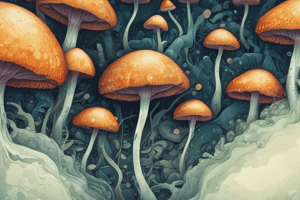Podcast
Questions and Answers
Fungi reproduce only asexually by binary fission.
Fungi reproduce only asexually by binary fission.
False (B)
Fungal hyphae can only be coenocytic, without septa.
Fungal hyphae can only be coenocytic, without septa.
False (B)
The vegetative structure of most fungi is called a mycelium.
The vegetative structure of most fungi is called a mycelium.
True (A)
Fungal cell walls are composed of cellulose and glycogen.
Fungal cell walls are composed of cellulose and glycogen.
Fungi are eukaryotic organisms with true nuclei.
Fungi are eukaryotic organisms with true nuclei.
The apical cell of the fungal mycelium is usually 10 to 20 µm long.
The apical cell of the fungal mycelium is usually 10 to 20 µm long.
Cellulose is present in the true fungal cell wall
Cellulose is present in the true fungal cell wall
The entire body of a fungus is referred to as thallus
The entire body of a fungus is referred to as thallus
Fungi reproduce only asexually, not sexually
Fungi reproduce only asexually, not sexually
Asexual spores produced by fungi include Zygospores and Ascospores
Asexual spores produced by fungi include Zygospores and Ascospores
Anamorph refers to the sexual stage of fungal reproduction
Anamorph refers to the sexual stage of fungal reproduction
Fungi with septa possess an undivided network of branching tubes.
Fungi with septa possess an undivided network of branching tubes.
Vegetative reproduction in fungi involves the reproductive portion of the fungal thallus
Vegetative reproduction in fungi involves the reproductive portion of the fungal thallus
Rhizopus nigricans is a plant pathogen that causes black mold on stale bread.
Rhizopus nigricans is a plant pathogen that causes black mold on stale bread.
Zygomycetes produce basidiospores as part of their reproductive cycle.
Zygomycetes produce basidiospores as part of their reproductive cycle.
Dimorphic fungi only exist in a mycelial phase of growth.
Dimorphic fungi only exist in a mycelial phase of growth.
The dimorphic switch in fungi from yeast to filamentous growth form is irrelevant in tissue penetration during infection.
The dimorphic switch in fungi from yeast to filamentous growth form is irrelevant in tissue penetration during infection.
Candida albicans always remains in a yeast vegetative growth form outside the host.
Candida albicans always remains in a yeast vegetative growth form outside the host.
Flashcards are hidden until you start studying




